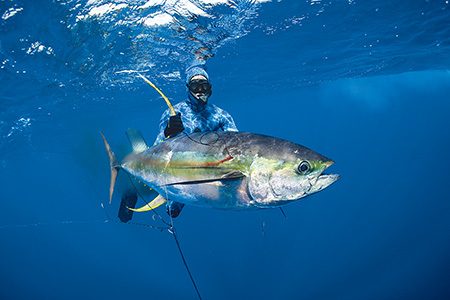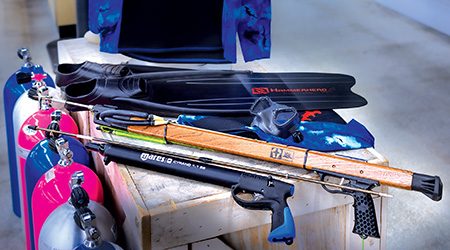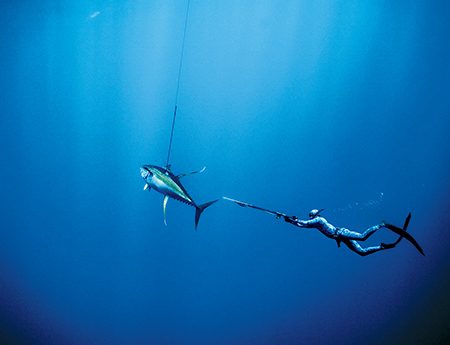The decision to sustainably harvest marine life can spark vigorous discussions among divers. Regardless of your views, there are benefits to understanding the equipment, procedures, and dangers associated with spearfishing.
The initial step is to research your spearfishing location. The government agency that regulates an area’s marine harvest publishes licensing requirements and creel limits. You can spearfish while on scuba or freediving, but there may be legal restrictions on the manner of take — in some locations it is illegal to spearfish while breathing compressed gas.
Diving for Harvest
Both scuba and freediving present challenges to a successful harvest. Freedivers make no sound or bubbles while stalking a fish, but their carbon dioxide tolerance limits their time at depth. Scuba divers are not as stealthy as freedivers but can remain underwater longer.
You must do standard risk assessment and contingency planning before spearfishing with either type of diving. Only one person from each buddy team should carry a spearing device, while the other person is the stringer. The pair can switch roles at a predetermined time or between dives. The spearfisher must be vigilant about maintaining contact with the stringer. If both divers are fishing, it is easy to get fixated on a target and ignore a dive buddy, increasing the chance they will become separated.

All divers must be proficient with their fishing equipment and in their crucial rescue and safety skills. Divers should practice neutral buoyancy techniques, unconscious diver rescue, solving entanglement issues, navigation, and surface marker buoy deployment.
If you’re diving from a boat, include the crew in dive and contingency planning. Always make sure a diving first aid kit and bandaging supplies for moderate and severe bleeding care are available. Divers and crew must know how to properly apply a tourniquet in case of potential delays in getting hospital care.
Equipment
Spearing devices fall into two main categories: spearguns and hand spears. Modern spearguns employ two different methods of propelling the shaft toward the target. A band gun utilizes externally stretched surgical tubing from the muzzle to the shaft tabs, and a pneumatic gun uses an internal piston mechanism and compressed air.
Hand spears are effective up close but require a secure grip and more hand strength than spearguns, which are more effective at longer ranges. Hand spears are commonly known as pole spears and Hawaiian slings. Fishers load pole spears by hooking a loop of surgical tubing attached to the pole in the dominant hand and gripping the shaft with the same hand while stretching the tubing. Releasing one’s grip propels the spear forward.

Hawaiian slings operate much like a bow and arrow, with a loop of tubing attached to a block of material with a hole drilled in it slightly larger in diameter than the spear shaft. The fisher inserts the shaft through the hole, nocks it in the tubing loop, and then pulls back and releases.
Be cautious when using spearfishing devices. Never point the muzzle or spear tip at anything you do not intend to shoot. Even if the bands are not under tension, treat the speargun or hand spear with consistent respect — mishandling can cause injury or damage dive equipment. Keep your trigger finger outside the trigger guard to prevent accidentally releasing a negligent shot in the excitement of a hunt or when dealing with buoyancy and water movement.
There is no catch and release when spearfishing. Spearfishers must be able to identify fish species and understand the effects of refraction in regard to relative size and distance. If the spear can travel beyond visibility, you may inadvertently hit something or someone.
Carefully choose your device to match the environmental conditions and target species. Hitting a shipwreck hull or a rocky ocean bottom may damage the spear. Orient yourself to have an appropriate backstop.
Always enter the water with your speargun unloaded. In heavy currents or choppy seas, it may be best for the crew to hand the device to you after entry. Unload the device before handing it — always butt first — to the crew, being mindful of the sharp point to minimize risk. Quickly stow the device to reduce the possibility of an injury on a pitching deck.
Hunting
A fish may not expire immediately, even after a successful shot. Larger fish have a significant amount of leverage over divers in the water.
The speargun shaft often connects to the stock or a float with monofilament or a synthetic braided line, but some divers prefer a free-shaft configuration with no connection after releasing the shaft. If you don’t use a surface float configuration, the fight takes place underwater. Be careful not to be pulled into a shipwreck or reef structure, and monitor your gas supply during increased exertion.
If the fish begins circling you, take action to avoid getting entangled in the line between the shaft and the speargun. You and your buddy must be prepared to untangle yourselves if it happens. Gain control of the fish as safely and as soon as possible. If the shaft is still embedded in the fish, hold the shaft on either side of the fish. This hand position offers a secure grip and reduces the possibility of the spear tip becoming embedded in you.

Do not let the appearance of a shark be a surprise and induce stress. Be aware of your surroundings, and make good decisions. If the site is known for large numbers of sharks, choose a different site. End the dive and change locations if sharks appear and become extremely interested in your fishing.
Sharks are highly effective predators. Ending the dive might be difficult, so maintain visual contact as much as possible. Sharks often swim out of visibility and then appear behind you, so keep your head on a swivel and expect to see the shark from a different direction.
Unless the shark is acting particularly aggressive, they will often approach with caution. If the shark gets too close, a gentle nudge or push at the snout or gills with the butt of the speargun can persuade the shark to find an easier meal. If all else fails, you can give up the fish to the shark, who should ignore you once you do. If you are able to bring the fish to the surface, remove it from the water as soon as possible.
Spearfishing can add enjoyment well after the dive has ended as you share the ocean’s bounty with friends and family. Remember that spearfishers have a duty to themselves, their buddy, and the ocean to make these dives as safely and responsibly as possible.
© Alert Diver — Q2 2024